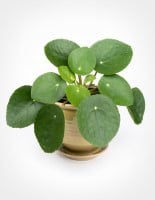
1. Pilea Peperomioides (Chinese Money Plant)
This is a new addition to my plant family. It is a relatively easy plant to care for; it needs medium to bright indirect light and only needs to be watered when the soil is almost dry. This plant also produces a lot of babies, so you can propagate them and share them with friends and family.
Tips for care: Bright, indirect sunlight; low water requirements









